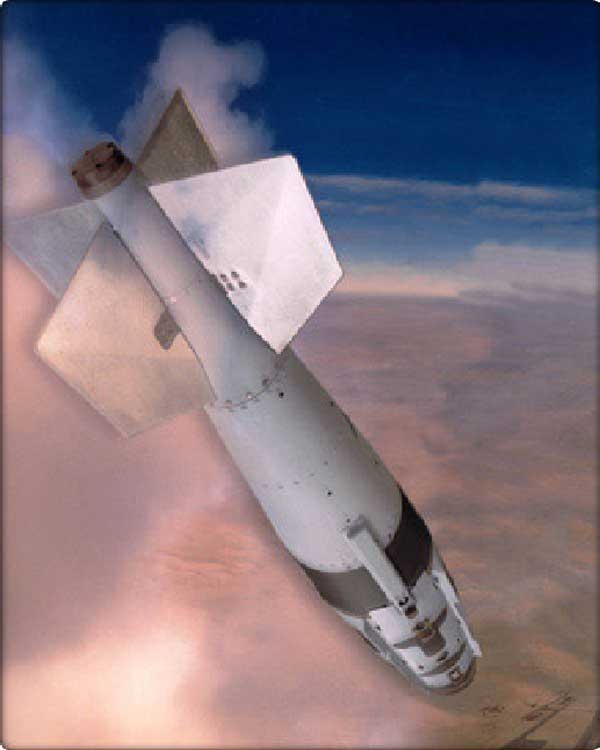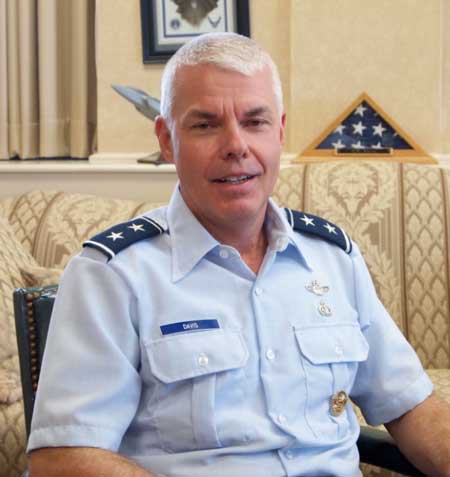01/19/2011 – In mid-October 2010, Second Line of Defense visited Eglin AFB and the Air Armaments Center. During the visit, SLD sat down with Major General Davis who is finishing his tour at AAC and has been nominated for his third star and the command at the Electronic Systems Center at Hanscom AFB.
SLD: You’re finishing your tour at the AAC and what do you feel are the most important achievements during your time here, especially in supporting the warfighters in Iraq and Afghanistan?
Major General Davis: I came here with this perceived notion that we — the USA — had gotten behind in our weapons planning and development activities compared to our platform development. I guess in some ways this turned out to be true. For the AORs we are fighting in today — for the operations the AF and coalition forces are conducting today — there is hardly a weapon being used today that hasn’t been significantly modified is some way. In many cases the weapons we are using today are being employed in a very different scenario than they were originally designed for.
And the Air Armament Center team has been very good at adapting something that was believed to be the perfect solution five years ago, to the entirely new situation of today’s combat. They’ve demonstrated an inherent flexibility, engineering-wise, test-wise, production-wise, to be able to take some of these weapons and give the folks that are in Afghanistan just what they need.
In at least in a couple of these cases — one in the Afghanistan AOR, one in another part of the world — we probably not could have anticipated how the weapons were going to be eventually use. But we have other situations where I think if we had followed the right disciplined approach, we could have anticipated needing the weapon that we’re now working in a quick reaction mode to deliver ASAP. We could have anticipated that this weapon was going to be needed now, or very close to now, if we had done things a little bit differently, five or six years ago. This process must start with future target set playing a key role in leading the design process. The process must not start with a set constraints defined by specific legacy platform dimensions.
(See an example of this development with the Small Diameter Bomb 1 Block 9.)
As we go forward on limited budgets our next challenge we will have to do a much better job of anticipating what the next need is going to be. How we get limited funding for what the next weapon requirement will be—a requirement that probably is not part of today’s battle—will be a real big challenge in the very constrained budget future.
SLD: One way to look at it is that weapons that you’ve modified here for use in Iraq and Afghanistan are really a function of investments made 30, even 40 years ago in the weapons enterprise? And I think folks tend to forget that you do have to make a significant investment for anything to last 30 or 40 years, that you can then leverage that investment.
So you’re making an investment, then you’re leveraging the investment, and so that’s an important characterization. And then the other issue, it seems to me that you’re raising, is, can we be smarter in anticipating future needs as we lay down new baselines for new weapons?
Major General Davis: What we’re seeing is we’ve got to do a couple of things. First of all, we absolutely have to realize that the weapons we’re going to build today have to anticipate tomorrow’s battles — in other words they will be used differently that originally designed and they must be flexible enough to adjust. Today we’re building a weapon that is in essence a very small sensor and attack platform that’s got to go find its own target and in some cases, delineate the target from various confusers. It’s got to be able to do its mission often without GPS and in all kinds of weather. Tomorrow’s weapons must be flexible enough to be effective in a constantly changing threat environment.
The threats are getting very, very intelligent and so, what used to be considered an acceptable level of investment for weapons may not provide what we need in the future. Yesterday’s weapon investment levels may not give us the capability to counter the threats that are growing out there today.
And this is the really challenging part the interesting part. Some of the threats that we have to deal today — using very interesting and creative methods –are already appearing on operational threat systems today. It is not just a future concern. Five years from now, they’re going to be evolved even further into the next generation, particularly, in the air-to-air jamming systems. We are already a little behind the timeline we need to track to be able counter some threats.
So it’s hard for most folks in this day and age to appreciate the level of investment that’s got to go into a new weapon program—because that weapon is now essentially a small airframe with a complete radar system, with a complete sensor system, a complete guidance system and a contains autonomous targeting capability. It is no longer just a missile or just a bomb. Our challenge, again, is meeting these needs with level or decreasing investment budget.
It’s interesting to see that when the Russians started building their new aircraft, touted as a 5th generation aircraft, they also started to develop the new weapons that would go with it at the same time. We’re not quite there yet in our airframe/weapons development processes. Our weapons are often have to play catch-up after the airframe gets built — in other words, the bay size, the dimensions you have to fit into, are fixed and this makes it difficult to optimize a weapons for a mission.
We have an opportunity to do better, as we look into what’s probably coming on the horizons out there in this thing called a “family” of long range strike systems. We have an opportunity to drive synergy from the start – and really, if you did this the right way, instead of defining your platforms and what platforms you need, you go figure out what your target set is that would help define what the effect you need really is and could quite possibly help define the size and shape of the platform.
That would help define what the weapon you needed is. That would help define what the platform size needed to be and what the platform characteristics would be. So as I mention the process must start with target set and work its way to the platform bay design. This is hard concept for most of us engineer and pilot types to accept.
If we can shape that process now, as we’re getting into new systems like the next gen platform, or the next generation bomber — if we can do this a little bit more effectively then maybe, maybe sometime in the future, senior leadership won’t have to ask, “How come we couldn’t anticipated this five or ten years ago?”
SLD: Let me ask you a final question. As we were about to build the F-35, and we have the F-22 in small, but significant numbers, where are the weapons for these platforms? The F-35 is really a 360-degree operational airplane and we really haven’t built the weapons yet for the 35 or the 22. In fact, one way to understand the F-35 is that it is the first airplane able to operate in 360 space and to manage that space with its integrated combat weapons enterprise. We clearly need to shape weapons strategy with this in mind.
Isn’t there an opportunity to build a weapon’s enterprise that could be highly synergistic with this stealth platform that could allow one to also think about, to use your phrase, the other assets that you might add? The remotely piloted aircraft and even support from surface ships and working with the long range strike platform. Isn’t that an opportunity to, as one builds towards the new aircraft, think beyond that to kind of a modular approach to get an effective outcome?
Major General Davis: I think there’s a lot of opportunity now because as I mentioned — in the past we’ve had to build weapons to match the hard confines of existing aircraft weapons bays. We are doing that today with the F-22 and the F-35. Or there are other cases where we built the aircraft around existing operational weapons. The F-35 was built around weapons like the JDAM and AMRAAM.
In the future I believe, the networks and interactions between an airplanes, or manned aircraft and UAVs, or aircraft/UAVs and ships on the sea will determine what weapons you are going to use and how they will be controlled. The weapons could be launched from a wide variety of airplanes and controlled through a variety of different nodes along the way –this will be a major factor in the kill chain of the future.
 Credit: http://www.boeing.com
Credit: http://www.boeing.com
We’re already started on what would be considered the next generation of weapons for both the F-22 and the F-35, and the only thing that we’re really constrained with right now is still weapon’s bay size but not much else.
The next gen bomber may be a different story, if we do the planning and requirements process correct, the bay will not be a limitation. This will allow us to really see what is the next limiting component of the kill-chain technology.
So we will deal with the fifth gen platforms, the F-22’s, the F-35’s, and we’ll figure out how to shape the weapons enterprise. We will shape an interactive system to make the weapon highly effective from the time it either gets information from the F-35, or the F-22, or is put in the battle space and picked up and controlled by another node in the grid — that node could be a Global Hawk, F-35, F-22, a regional Air Operations Center, or another platform acting as a picket battlefield airborne control.
There’s an unlimited set of options of how we will manage and employ the entire kill. How we throw the weapon out of that bay is still somewhat constrained, but for the period from the time from launch to target destruction is still basically limited only by a clean sheet of paper.


